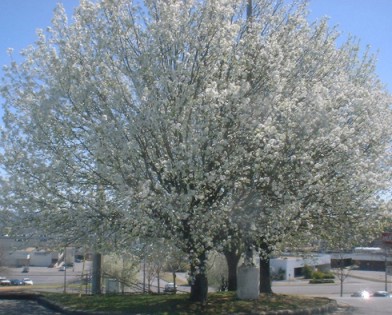|
Gardens Ablaze |
||
|
|
Bradford
Pear |
|
|
Detailed Tree Profiles Site Map
Home
|
There's no disputing a street lined with Bradford Pears in bloom is a real sight to behold. This tree has a beautiful rounded or teardrop-shaped growth habit that is covered with delicate white blooms in early spring, with a nice dense canopy in the summer and decent fall color. Widely planted as a street tree all over the USA in the last few decades, the Bradford Pear is a mainstay in almost every city and town. Unfortunately, it has taken a few decades for us to come to the realization that this tree is not quite the dream landscape solution we thought it was. The main complaint is that as the tree matures (and it matures fast), the branches overwhelm it and break off in big chunks, ruining the symmetry and creating a deformed eyesore. Another problem is that the flowers stink, with descriptions ranging from sickly sweet to a urine-type smell. This is not a tree you want to plant outside Grandma's window. Another big problem is environmental, as the Bradford Pear can and does escape into the wild, competing with natives for sunlight and nutrients. Assuming you are now not considering planting a new Bradford Pear, there are those of us who have inherited this tree with our property, and a decision has to be made as to what to do with it. Most people in this situation seem to just let it be and enjoy it until it falls apart, as it really is a beautiful thing to see in the spring. If you are one of these, then you will probably have to do some maintenance here and there (namely pruning) in an effort to delay the inevitable. Pruning should be done after flowering and the object is to remove smaller branches from the middle of the tree and any larger branches that are too close together. If any branches are within a foot or so of each other, remove the smaller one. If any branches are spreading horizontally, leave them alone. If two large healthy branches are within a foot of each other, remove the one that is the most upright. Large branches will require 2-3 cuts starting from the outside to avoid damaging the bark on the branch wood that will remain. You are striving for a well-balanced shape and a somewhat open canopy so there won't be competition that weakens the individual branches. With this type of maintenance you can probably get a few more years of enjoyment out of your Bradford Pear, but bear in mind that it won't last forever. Another concern with Bradford Pears are the suckers that sprout where the tree's roots reach the soil surface. The easiest way to control these is by mowing regularly, but if this is not possible, a thin layer of mulch should keep the problem to a minimum. Do not put heavy mulch down or try to dig the suckers out, or you will damage the tree itself. It should be mentioned that even though the Bradford Pear is a pear tree, it is grown as an ornamental and not for it's fruit, which is small, round and non-edible.
Custom Search
|
|
|
Gardens Ablaze |
||
 When
choosing landscape trees, most of us do a quick mental checklist of the
attributes we want, such as seasonal interest, affordability, growth rate,
growth habit, availability, invasiveness, maintenance, and environmental
benefits. In the case of the Bradford Pear, this is a very, very good policy,
as there are definite issues with this particular tree that a homeowner
or landscaper should take seriously before ever putting a spade into the
ground.
When
choosing landscape trees, most of us do a quick mental checklist of the
attributes we want, such as seasonal interest, affordability, growth rate,
growth habit, availability, invasiveness, maintenance, and environmental
benefits. In the case of the Bradford Pear, this is a very, very good policy,
as there are definite issues with this particular tree that a homeowner
or landscaper should take seriously before ever putting a spade into the
ground.